International Journal of Astronomy and Astrophysics
Vol.1 No.2(2011), Article ID:5685,7 pages DOI:10.4236/ijaa.2011.12014
Concerning Diamond and Gold-Bearing Astropipes of Mongolia
1Paleontological Center, Mongolian Academy of Sciences, Ulaanbaatar, Mongolia
2VNIIgeosystem, Warsaw Highway, Moscow, Russia
E-mail: ddorj2001@yahoo.com
Received March 15, 2011; revised April 19, 2011; accepted May 16, 2011
Keywords: Astropipe, Diamond, Impact Crater, Spherules Meteoritic Iron, Shatter Cones, Pyrope
Abstract
In this paper we present summation of thirteen year’s investigation of the all diamond-bearing structures of Mongolia. Four gold and diamond-bearing astropipe structures of exemplified by the Agit Khangay, Khuree Mandal, Bayan Khuree and Tsenkher astropipes of Mongolia. Detailed geological and gas-geochemical investigation of the diamond and gold-astropipe structures show that diamond genesis is an expression of collision of the lithospheric mantle with the explosion process initiated in an impact collapse meteor crater.
1. Introduction
Dorjnamjaa et al. [1-5] have established for the first time the presence of diamond and gold-bearing ring-shaped impact structures called “astropipes” in Mongolia at Agit Khangay, Khuree Mandal, Bayan Khuree, and Tsenkher (Figure 1). The term ‘astropipes’ is a neologism in Earth science and these structures are unique in certain aspects. This term was proposed for this type of newly recognized meteorite crater as compared with an “astrobleme” [2,3,6].
Many meteorites are large enough to create impact craters. The Mongolian astropipes are genuine ‘meteorite crater’ structures but they also contain kimberlite (mantle-derived) diamonds and gold. Within the terrestrial planets this process is considered as a rare phenomenon that occurs especially in the evolution of both the atmosphere and mantle. Our preliminary investigation of petrological and geochemical databases of diamondiferous kimberlite-like “agizite” or impact-related rocks from astropipe structures has resulted in the creation of a petrologic model of kimberlite-like formation, one that logically combines a large variety of petrographic, mineralogical and geological features.
The main positions of this model are as follows:
1) Geochemical composition of impact-diamond generated rocks a sequence of their bedding within the astropipes and diamond contents are interralated and determined by depths of impact-generated or kimberlitelike melt formation within the mantle.
2) An additional factor of petrological and geochemical diversity of impact-generated formation is considered to be the compositional inhomogeneity of magma generation zones of the mantle at the expense of inclusions of eclogite-like paragenesis, enhancing the intensity of mica kimberlite formation comparing with baric standard and their corresponding diamond contents.
3) Evolution of impact-diamond-generated magmatism had been proceeding from more deep-seated (> 100 km) levels to lees deep-seated (< 100 km) ones, and magma generation zones in the considered astropipe regions, that was likely to trace a displacement of lithosphere plate under a hot spot within the Paleoasian ocean structures.We must recognize that the mantle substructure is revealed close to terrestrial surface within the Mongolian astropipe structures. True, the proposed model of impact-diamond-generation composition, although approximating rather closely to reality, calls in many respects for refinements according to isotope geochemical and mineralogical data, also geophysical log. The pursuance of fundamental investigations of discovered astropipe structures with the complex mastering of information on mantle inclusions, mineralogical, structural petrography, geochemistry and petrochemistry is quite possible.
The Mongolian astropipe structures recognized to date include:
Agit Khangay (10 km in diameter, 47˚38'N; 96˚05'E),
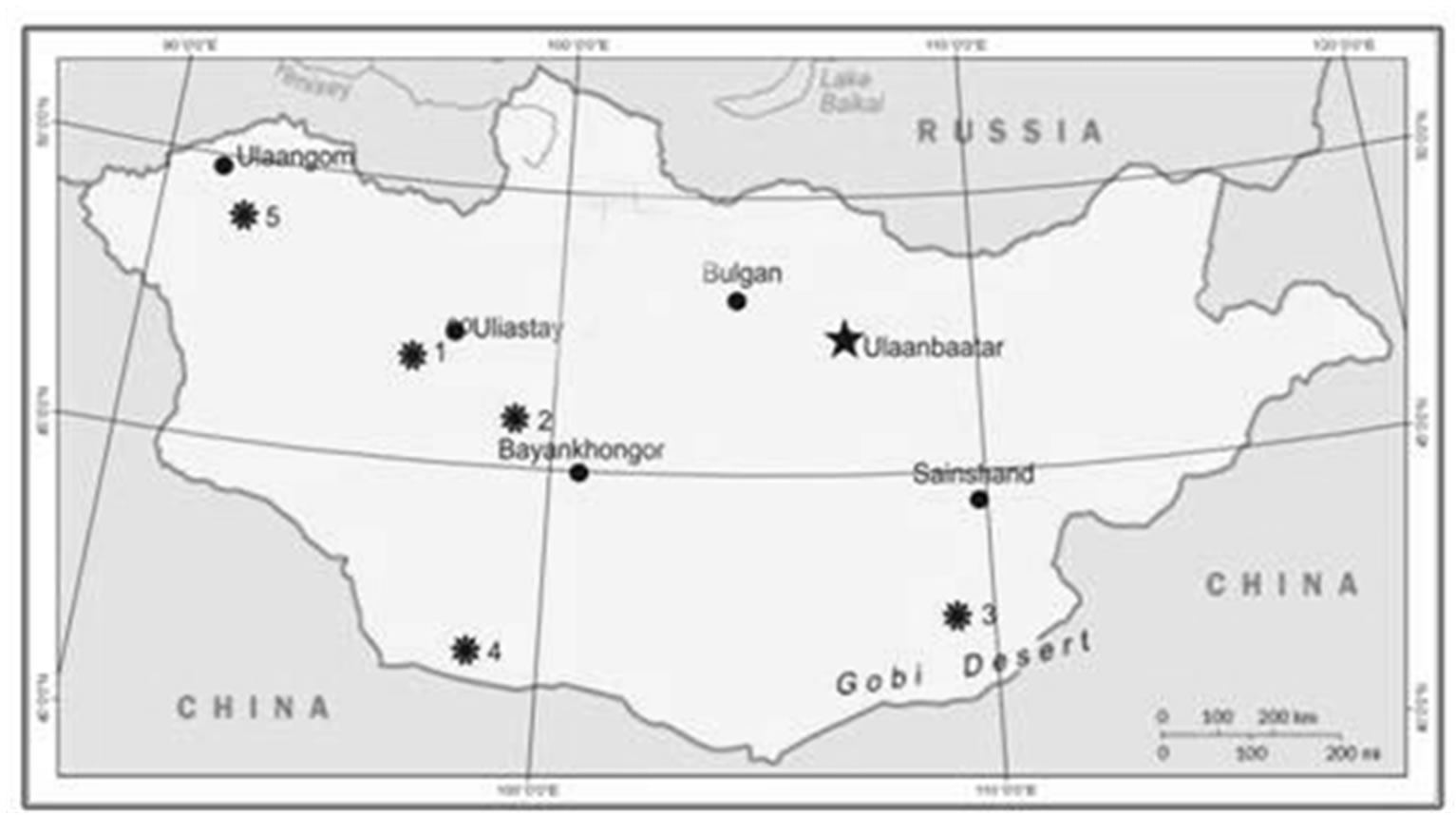
Figure 1. Location of the Mongolian diamond-bearing astropipe structures; Type I, studied in 1997-2009: 1, Agit Khangay (47˚38'N; 96˚05'E) 2, Khuree Mandal (46˚28'N; 98˚25'E); 3, Bayan Khuree (44˚06'N; 109˚36'E); 4, Tsenkher. (43˚36'N; 98˚21'E); Type II, insufficiently studied diamond-bearing structures: 5, possible astropipe structure “Flying Saucer” (49˚25' N; 92˚05'E).
Khuree Mandal (D = 11 km, 46˚28'N; 98˚25'E); Tsenkher (D = 7,3 km, 98˚21'N; 43˚36'E), and Bayan Khuree (D = 1 km; 44˚06'N; 109˚36'E) impact-magmatic pipes have been distinguished in Mongolia (Figure 1). These astropipes are well-protected from erosion and active denudation, and characterized by both good natural exposures and a diversity of different impact-derived, shocked metamorphic, and magmatogenic rocks and minerals.
2. New Methodology
The scrutiny of adsorbed gases in rocks of diamondiferous provinces is a new nontraditional prospecting method to determine gas concentration and composition of the samples (fraction 0.1 - 0.25 mm) by gas chromathography. This is accomplished by heating the sample in a reactor of special design up to a temperature of 200˚C in an argon environment. The method has been substantiated by experimental investigation and its practical application verified for the study of numerous geological objects-kimberlite pipes, astropipe impactites, volcano structures and etc. [1-3].
The adsorbed gases in the Mongolian astropipe impactites (Agit Khangay-sample 32/99, Khuree Mandal sample 17/03) have been compared with that of an analogous form in volcanic rocks of modern (Volcano Gorelii, Kamchatka) and ancient (Maikhant-sample 25 - 04, and Zuun Busluur-sample 36/04 from Dariganga plateau, Mongolia) volcano eruptions as well as kimberlite pipes (Victory-1, Shandong province, China). As a result our data with marked specifications of gas composition (HCGaf is adsorbed form of the hydrocarbonic gas) of the astropipe rocks indicate their similarity to the composition of the kimberlite pipe gases (Figures 2 and 3).
In this study, all the minerals were investigated using thin sections, X-ray spectral and structural microanalyses, and scanning electron microscopy [2].
3. Results
3.1 Khuree Mandal Astropipe Structure
The Khuree Mandal astropipe structure (Figure 1.2), 220 km N-NW of Bayankhongor city in central Mongolia is within the Upper Paleozoic volcanic intramontane Buutsagaan depression with a diameter of 11 km and has a similar geomorphological position as the Agit Khangay astropipe crater. As shown in Figure 4, the principal morphostructural elements of the astropipe ring are: Inner
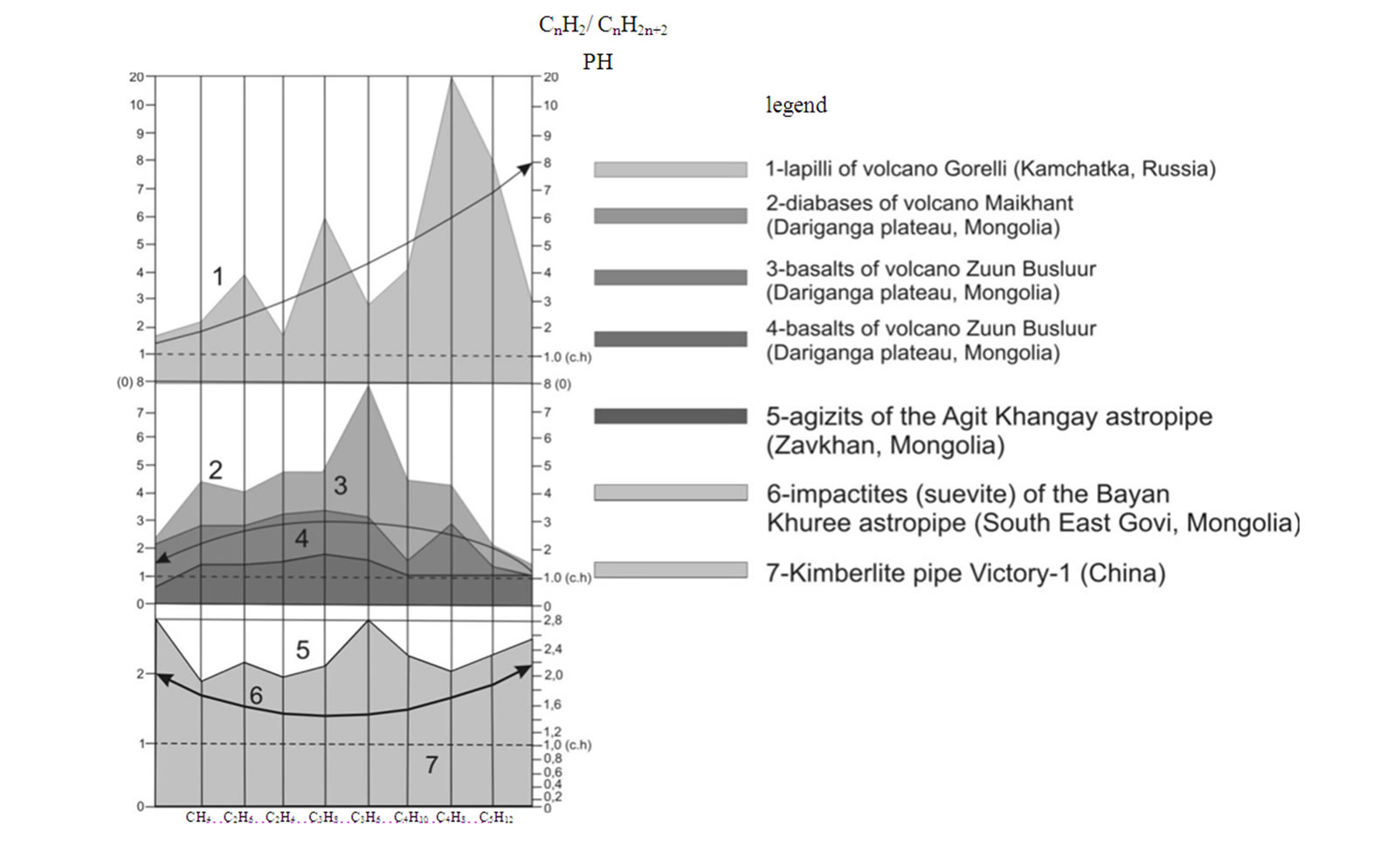
Figure 2. Contrast curves of adsorbed form of the hydrocarbonic gas (HCGaf) components (see Legend).

Figure 3. Comparison of concentrations and composition of HCGaf in volcanic rocks from eruptions with rocks from astropipies and kimberlite.
(small) diamond-gold-bearing pediment plain (I); Inner ring-shaped rise or Inner tectonomagmatic bar (Central hilly rise-II); Central ring depression (III); Outward circular bar (IV); Inner ore-bearing crater mould (V). The astropipe relief morphostructures have an inversion nature with respect to the non-meteoritic country structures. The main difference is characterized by radial-ring morphostructures (Figure 4), which are represented by various ore-bearing and mineral formation complexes.
Suevite-like rocks (fluidizate) and volcanic breccia from various parts of the crater and central hilly rise are characterized by the presence of olivine, coesite, moissanite, khondrite, picroilmenite, pyrope, phlogopite, orthite, and gold (from 0.13 to 6.33 - 32 g/t) closely associated with mantleand impact-derived fine diamonds (Figure 6; 0.1 - 0.5 to 2.5 mm in size). Special pressure and temperature conditions are necessary to account for the coexistence of phlogopite, pyrope, picroilmenite, gold and other accompanying accessory minerals with the diamonds. It is reasonable to assume that the Khuree Mandal astropipe structure is closely related to diamond-bearing rocks and is analogous to the diamond-bearing lamproites of the ‘Argail’ pipe of Australia [2]. So-called shatter cones that were produced when the shock wave traversed the Permian volcanogenic rocks were first described by us in connection with the Khuree Mandal and Tsenkher astropipe structures (Figures 5 and 10). Meanwhile, shatter cones are known from many meteorite craters on the Earth as being typical of impact craters [1].
3.2. Agit Khangay Astropipe Structure
The Agit Khangay astropipe structure (Figure 1.1) in western Mongolia was formed within a Permian granite

Figure 4. Geological map and cross-section of the Khuree Mandal astropipe structure; 1-Cenozoic: coarse-fragmental rocks composing terraces (conglomerate, gritstone with diamonds, tektite glass, cosmic spherules); 2-Diluvial and diluvial-proluvial deposits with gold, moissanite; 3-Allogenic lavabreccia boulder, gravel, sandstone, loamy sand with gold mineralization, meteoric matter; 4-Mesozoic: mural palingenetic granite with fluidizate-like loamy sand volcanic breccia and plural acute-angle xenoliths; 5-Carboniferous (Buutsagaan Formation)-Permian (Khureemaral Formation): terrestrial terrigenous-volcanic rocks; 6-Mesozoic intrusive contact with diamond and gold-bearing coarse-fragmental rocks; 7-Radiating gold-bearing basic dykes and lithic-crystal tuffite; 8-Pseudoslate cover, neck, veins, authigenic breccia, tagamite-like complex forming radiating and ring structure; 9-Stepped boundary between a central hilly rise and ring depression; 10-Stepped boundary between an inner (small) diamond-gold-bearing pediment plain (I) and central hilly rise (II); 11-Arcuate fault and ring fracture inside of the central hilly rise; 12-Suevite or fluidizate-like granitic breccia; 13-Prospecting trench (Tr) and shaft (Sh).

Figure 5. Shatter cones (size approx. 1.0 m) in the Khureemaral basic lava flow in the Khuree Mandal astropipe geostructure. GPS: 46˚31′50″N; 98˚20′04″E. Photo of Ts. Amarsaikhan.

Figure 6. Diamond octahedra from the Khuree Mandal astropipe structure. The size of crystals is 0.1-5.0 mm.
massif. The impact geostructure is at the northern edge of the Zavkhan tectonic zone, some 60 km southwest of Uliastay city. The crater is surrounded by a raised rim with a total diameter of about 10 km. The country rock of the crater is an Upper Paleozoic magmatic assemblage overlain in places by Quaternary alluvial deposits. The crater rim or bank consists of a disrupted ring-like ridge reaching a height of about 450 - 500 m, and the crater itself is infilled with shattered and shocked granite (agizite-new name from this structure), which is characterized by ejecta, cataclasite, and authigenetic breccia. Agizite is new Mongolian word of gold and diamond-bearing rock which was multiple published characteristic for Agit Khangay astropipe structure. Agizite is atypical (unorthodox) suvite-like or beresite-like metasomatic rock which contains microdiamond, moissanite, pyrope, stishovite, coesite, kamacite, tektite and etc. Most panned samples and hand specimens contain fine diamonds (Figure 7) with octahedral habit (size of 0.2 - 0.43 to 2.19 mm with a weight of 6.0 - 6.4 mg or 0.034 - 0.1 carat); gold (from 0.1 to 3 - 5 g/t ); platinum; moissanite (mineral of meteorite-siliceous carbon size of 0.6 mm); pyrope; rhenium; chrome spinel; kamacite; khangaite (tektite glass, 1.0 - 3.0 mm in size); picroilmenite; coesite; khamrabaevite (mineral of meteorite-titanic carbon); fayalite; sheelite; graphite-2H, etc.
Impact shock effects include the presence of coesite and pseudotachylite in samples of granites and abundant vesicular and flow-structured quartz glass. Our work on acid-dissolved residues of impact melt rocks from the crater and from panning has revealed the presence of silicon carbide (moissanite) crystals, closely associated with impact microdiamonds. Of special interest is the large amount of magnetic spherules (meteoritic dust or rain) gathered in the region. These black magnetic balls (from 0.05 - 0.1 to 1.0 - 5.0 mm) are characterized by high content of Ti, Fe, Co, Ni, Cu, Mn, Mg, Cd, Ca, Cl, Al, Si, K, Au and represented by oxides of iron. The spherules (Figure 8) differ noticeably from micrometeorites and because of their contents of iridium, rhenium, khangaite and khamrabaevite. They are probably not
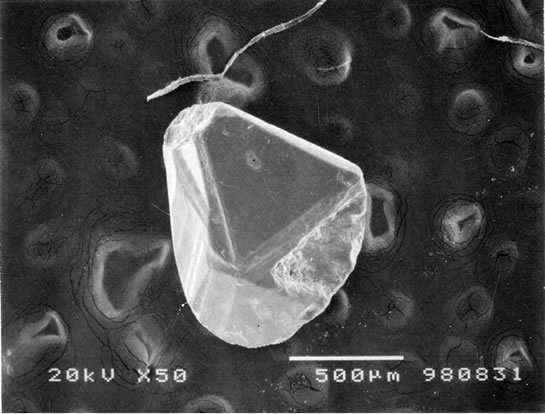
Figure 7. Trihedral diamond crystal (face of octahedron) from agizite of the Agit Khangay astropipe structure.
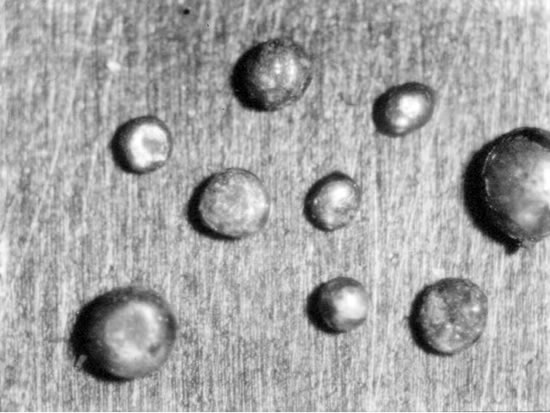
Figure 8. Black magnetic balls or meteoritic (iron) dust (size of 0.1 to 5.0 mm) from the Agit Khangay astropipe geostructure.
terrestrial tektites.They may alien planetary materials, possibly cosmic relics of the impacting Agit Khangay ‘body’.
By means of morphostructural, geochemical, as well as by mineral concentration methods, we have been able to identify the unique occurence of gold associated with diamonds in the Agit Khangay crater. Primary occurrences of gold with contents 0.1 to 3 - 5 g/t are confined to the central crater up to 2 - 2.5 km in plane. These primary gold occurrences are accompanied by placer gold and scheelite of before meteoritic origin.
An analogous gold-bearing impact crater, ‘Khuree Mandal’ has also been discovered in central Mongolia.
3.3. Bayan Khuree Astropipe Structure
This circular 1 km-diameter astropipe structure in southeastern Mongolia (Figure 1.3) is located about 100 km south of Sainshand city. Mesoproterozoic micaschists strike NE and in places are covered by Cretaceous sediments and Quaternary sands. The crater depression lies across folded country rocks is filled by eolian sands. The apparent depth of the crater depression is about 30 - 40 m. The rim reaches 25 - 30 m high and consists of fractured and brecciated schists. According to Dorjnamjaa et al. (2,6) the clastic cement of the allogenic breccias contains impact glass (3 - 5 mm), shocked quartz grains, pyrope, olivine, chrom diopside and microdiamonds (Figure 9; 0.5 × 0.4 mm in size). Ejected brecciated blocks are found at a distance of ~300 m from the eastern crater rim. A remnant of the postimpact terrigenous sedimentary cover, with early Cretaceous fossils, occurs not far from the rim and consists of sandstone lenses which bear shocked quartz grains that have one or two sets of planar deformation features (9). According to radiometric dating on impact-melt rocks, the crater was formed close to the late Jurassic Cretaceous (150 ± 20 Ma) boundary [7].
3.4. Tsenkher astropipe structure
The Tsenkher astropipe structure (Figures 1.4) in southern Mongolia is present at the southeastern edge of the NW-SE-trending mountain range, the Edrengyin Nuruu, and is located on a Cenozoic basin fill that is gently dipping to the south. Komatsu et al. [8] first discovered and reported the possible impact structure during his examination of RADARSAT standard mode images of the region for paleoenvironmental reconstruction. We studied this structure in detail during 2006-2007. It’s diameter is about 7.3 kilometers, surrounded by a raised rim and with a relatively well-preserved blanket of ejecta materials.
The region is dominated by the Altay Mountain Ranges, which are primarily Silurian-Devonian island-arc and continental Mesozoic-Cenozoic platform assemblages. A panned sample contains impact glass, pyrope, olivine, gold and moissanite. Shatter cones have been revealed from volcaniclastics within the northwestern part of the raised rim (Figure 10). Shatter cones or cones of shattering are formed as a result of action of the shock wave connected with meteoritic impact. So-called shatter cones were produced when the shock wave traversed the Devonian volcanoclastics. Meabwhile, they are known from many meteorite craters on Earth as being typical of impactites. Cones of split off outwardly remind a texture (cone-in-cone) in rocks. The hatching on surface of cones is scattered in form of horse’s tail from top of cone to their base.
4. Conclusions
Summing up the material presented here, let us note some fundamental aspects:
1) All the described meteorite craters possess reliable topographic, geological, mineralogical, geochemical, and aerial mapping data, also some geophysical and petrological features (especially shock metamorphism) have been found, all of which indicate that these structures are a proven new type of gold-diamond-bearing impact structure, termed here ‘astropipes’.
In accordance with Kvasnitsa et al. [9], we can conclude that diamond is a polygenous mineral, which is formed not only in conditions of the Earth’s deep crust/ mantle, but also in the super-velocity collision of celestial bodies as well as during the processes of gas condensation in interstellar space. The essence of the phenomenon is mantle manifestation and plume of a combined nuclearmagma-palingenesis interaction.
5. Acknowledgements
This research was supported by funding for science technological and science projects of Mongolia, “Mongol

Figure 9. Diamond octahedron of from the Bayan Khuree astropipe geostructure. Size of crystal is 0.5 × 0.4 mm (from Dorjnamjaa et al. [2]).
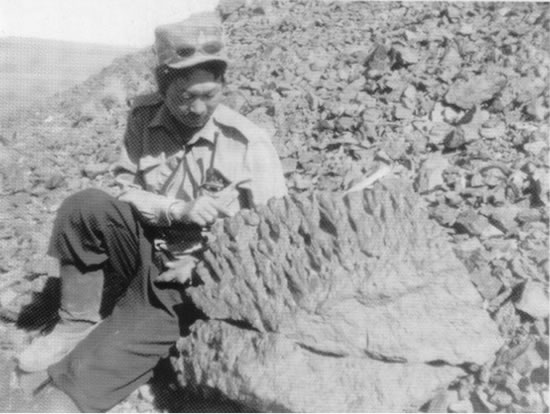
Figure 10. Shatter cones (size approx. 15.0 cm) in Devonian volcaniclastics of the Tsenkher astropipe structure. GPS: 43˚37′N; 98˚20′E (from Dorjnamjaa et al. [2]).
Diamond”, in 2004-2006, “Diamond-bearing astropipe geostructures” in 2007-2009, and by additional scientific support from Moscow State University (MSU) and CNIGRI ALROSA Co. Ltd. We are grateful to L.S. Kondratov (VNIIgeosystem, Moscow) for the adsorbed form gas analyses in impactites; V.K. Garanin (Problem Laboratory of diamond deposits, Geological Department of MSU); Elena L. Zhegallo (Paleontological Institute of Russian Academy of Sciences); and N.N. Zintchouk (CNIGRI, ALROSA) for their scanning electron microscopy (SEM) studies of the diamond microcrystals. We are also sincerely thankful to Academician R. Barsbold (Paleontological Center, MAS) for their constructive assistance.
6. References
[1] D. Dorjnamjaa and D. M. Voinkov, “New Diamond And Gold-Bearing Structures of Western Mongolia,” Geoinformatika, Vol. 4, 2003, pp. 46-49.
[2] D. Dorjnamjaa, D. Selenge and Ts. Amarsaikhan, “Diamond-Bearing of Some Mongolian Geostructures and Further Prospects,” Eternal Letter, Ulaanbaatar, 2008.
[3] D. Dorjnamjaa, D. Selenge, Ts. Amarsaikhan and B. Enkhbaatar, “Some New Scientific Facts on the Diamond and Gold-Bearing Astropipe Geostructures of Mongolia,” Goldschmidt-2010, Knoxville, 2010, p. 1454.
[4] D. Dorjnamjaa, D. Selenge and K. V. Garanin, “Diamond-Bearing Astropipes in Mongolia, Their Recognition and Characteristics,” Goldschmidt-2006 Conference, Melbourne, 2006.
[5] D. Dorjnamjaa, A. V.Tolstov, E. I. Boris and Kh. Bolormaa, “The New Diamond and Gold-Bearing Astropipe Structures of Mongolia,” Proceeding of XXXII International Geological Congress, Florence, 2004, p. 1210.
[6] TWAS, “The Academy of Sciences for the Developing World,” 2008, p. 494.
[7] V. L. Masaitis, “Impact Structures of Northeastern Eurasia: The Territories of Russia and Adjacent Countries,” Meteoritics and Planetary Science, Vol. 34, No. 5, 1999, pp. 691-711. doi:10.1111/j.1945-5100.1999.tb01381.x
[8] Komatsu, “A Possible Impact Crater Structure in Southern Mongolia,” Lunar and Planetary Science Conference, Houston, 1998, pp. 17-19.
[9] V. N. Kvasnitsa, N. N. Zintchouk and V. I. Koptil, “Typomorphism of Diamond Microcrystals,” Nedra, Business Center, Moscow, 1999, p. 224.

